







Rhythm Terminology, Symbols and Note Values

What do we mean by note values?
When we speak of note values we are simply talking about slicing a specific
(measure) or length of time into smaller portions. It is not very much
different from measuring the time of day on any clock. When measuring rhythm
though, the length of time being measured is shorter and that length of time
may vary. We may count rhythm many various ways and at different speeds.
What is Tempo?
The word 'tempo' is Latin for time, or more accurately in the musical sense,
the speed at which we play or feel a piece of music. The drummer must feel the
tempo of a song before trying to read or play it.
What do we mean by Beat?
The 'beat' or 'meter' of a song is determined by its count. We count some
measures of songs in sections
of fourths with the beat count being a repetitious, one , two, three, four.
Other songs may be measured
differently. This count and/or beat flow is determined by the time signature.
4/4 is indicating four fourth-note
counts to the measure, where 6/8 is indicating six eighth-note counts to the
measure.
The time signature is a formula that determines the counting process for
each measure in
a particular musical piece. For example 4/4 is a time signature formula that
tells us to count a
piece of music in fours. The top number tells us 'how many' counts and the
bottom number tells
us 'what kind' of notes are being counted. In the case of 4/4 the time
signature is instructing us
to feel and count four/fourth notes to each following measure.
What do we mean by 'Down Beat'?
The 'down beat' is always the first count in each measure. It's usually the
recurring 'boom' sound of the music
and most often falls on a 'one' or 'three' count in 4/4.
What do we mean by 'UpBeat' or 'Backbeat'?
We AREN'T speaking in terms of the 'UP' position of the
conductors wand, here. The 'UPbeat' (in this context) is the 'OFFbeat' or the
'negative' cycling flow
of a beat pattern. It's usually the counts of 2 and 4 in common (4/4) time
signatures. To state
it simply, it's usually the repeating, accented 'snap' of the SNARE sounds,
within a repetitious
beat pattern.
The Music Staff
We normally write drum notation on a music staff like any other instrument.
The music staff usually consists of five lines and four spaces. Each piece of
the drumset will occupy a specific line or space on the staff. The writer
should always offer a 'code' that explains these designations to the reader.
Sample Staff with Code:
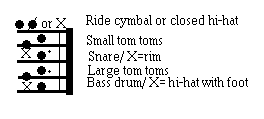
NOTE: Extra lines are sometimes added to the staff when an abundance of
percussion/drum parts deem it necessary.
What is a Bar?
In music notation a bar is a vertical line or divider used to mark off the
'measures' to represent equal segments of time.
What is a Measure?
A 'measure' is the space between two bars
. It is the segment or slice of time that is to be counted as indicated
by the time signature. We often refer to a 'measure' of music as a 'bar' of
music. I'm
showing two full 'bars' or 'measures', in the illustration, below.

NOTE VALUES
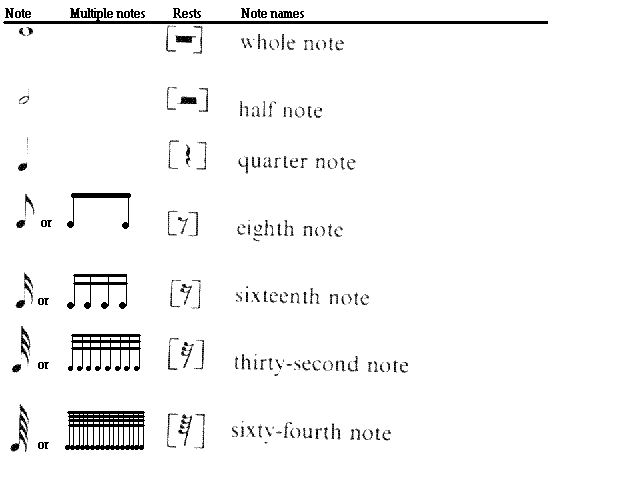
Triplets
A triplet is simply a way of expressing or playing three notes within the
time of two. For
example, three half note triplets will occupy the same space and time as two
half notes. Three
quarter note triplets will occupy the same time as two quarter notes. A form of
triplets will exist
for every note value, from whole notes to sixty-fourth notes and beyond. This
will be a little
easier to understand as you study the exercises below. Beginning students may
wish to skip whole,
half note and quarter note triplets at first. These triplet forms will make
more sense after you
have been playing a while longer.
SPECIAL NOTE: Whole note triplets will be possible in 8/4 time but they will
not exist in 4/4.
For the sake of simplicity, I've omitted whole-triplets in the tab below, since
they are so rarely used.
Reading Note Values
The following illustration will help you visualize the way that note values
work together to create
a visual picture of common rhythms. The notes on the top line are to be played
on the snare (or computer desk)
and the (quarter) notes on the bottom line are to be executed with the right
foot or bass drum. The right foot
or bass drum should remain in a steady tempo as you play all the snare notes.
When you can play this
entire exercise forward and backward without losing (bass drum) tempo, you will
be at genius level. It is
very difficult, so take it in stages. Gain the ability to play the most
important part, whole notes through
sixteenths.
R or r = right hand
L or l =left hand.
 VIDEO: Watching the video may help. Don't worry about doing
this perfectly for now. Just try to understand the rhythmic relationships
between each of the note values. Try to gain the ability to recognize them in
the music playing
around you every day and eventually call the various values by-name as you hear
them. We'll study these concepts again as we study fills. BEGINNERS SHOULD NOT
WORRY ABOUT
BEING ABLE TO DO THIS PERFECTLY. It will come to you gradually as you study the
other lessons of the course. Understand the concept . . . then move on.
VIDEO: Watching the video may help. Don't worry about doing
this perfectly for now. Just try to understand the rhythmic relationships
between each of the note values. Try to gain the ability to recognize them in
the music playing
around you every day and eventually call the various values by-name as you hear
them. We'll study these concepts again as we study fills. BEGINNERS SHOULD NOT
WORRY ABOUT
BEING ABLE TO DO THIS PERFECTLY. It will come to you gradually as you study the
other lessons of the course. Understand the concept . . . then move on.
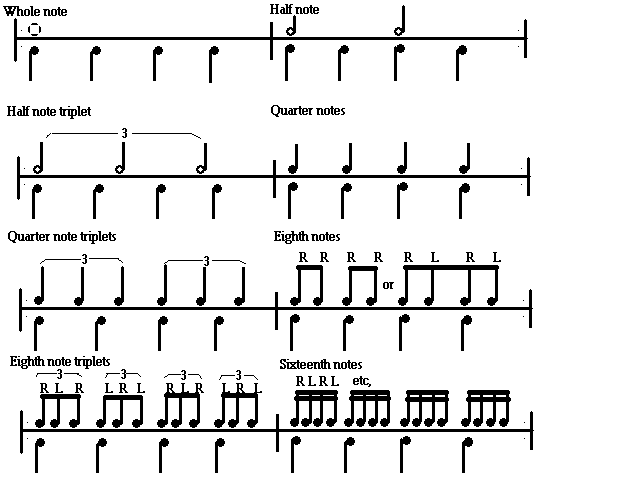
With that accomplished, try playing from sixteenths to sixty-fourths.
Next, try working backward from sixty-fourths.
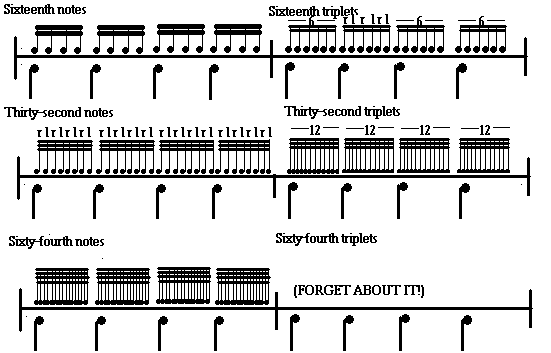
 VIDEO:
VIDEO:
Remember! We're only human. The tempo will need
to be a bit slower to accomplish these faster note values. Understand them,
then move on.
Speed and perfection will occur as you jam, and continue through the other
lessons of this course.
Dotted Notes
A dot beside any note-value or rest will increase the value by half. For
example, a dotted half-note will have
the same value as three quarter-notes. A dotted quarter-note will have the same
value as three eighth-notes and a
dotted sixteenth will equal three thirty-second notes. Since sustaining or
holding a note is difficult with
most percussion instruments, the note should be struck and counted. The actual
sound of the note will usually
die-out, long before the count is complete.
The
following E-book explains why dotted-notes were
created, and why they could/should be eliminated completely from the current
note-value system of reading/writing rhythm. You should check this out. It's an
in-depth, provocative, compelling, new, and comprehensive study of this topic.
You'll come away from it as a rhythm guru!
Other Musical Expressions and Signs
Crescendo: This is a musical symbol that may be placed over a series of notes,
telling the player to increase volume from soft to loud.
Diminuendo: A musical symbol placed over a series of notes, telling the player to
begin loud and decrease volume to very soft.

Accents
When the < (accent mark) is placed over an individual note it indicates that
the player should play that note louder than the rest.
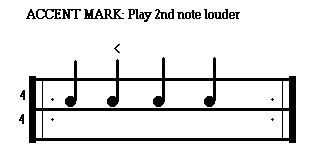








![]() VIDEO: Watching the video may help. Don't worry about doing
this perfectly for now. Just try to understand the rhythmic relationships
between each of the note values. Try to gain the ability to recognize them in
the music playing
around you every day and eventually call the various values by-name as you hear
them. We'll study these concepts again as we study fills. BEGINNERS SHOULD NOT
WORRY ABOUT
BEING ABLE TO DO THIS PERFECTLY. It will come to you gradually as you study the
other lessons of the course. Understand the concept . . . then move on.
VIDEO: Watching the video may help. Don't worry about doing
this perfectly for now. Just try to understand the rhythmic relationships
between each of the note values. Try to gain the ability to recognize them in
the music playing
around you every day and eventually call the various values by-name as you hear
them. We'll study these concepts again as we study fills. BEGINNERS SHOULD NOT
WORRY ABOUT
BEING ABLE TO DO THIS PERFECTLY. It will come to you gradually as you study the
other lessons of the course. Understand the concept . . . then move on.




![]() Drum Solo Video: Click to 'LEARN'
Drum Solo Video: Click to 'LEARN'![]()
![]()